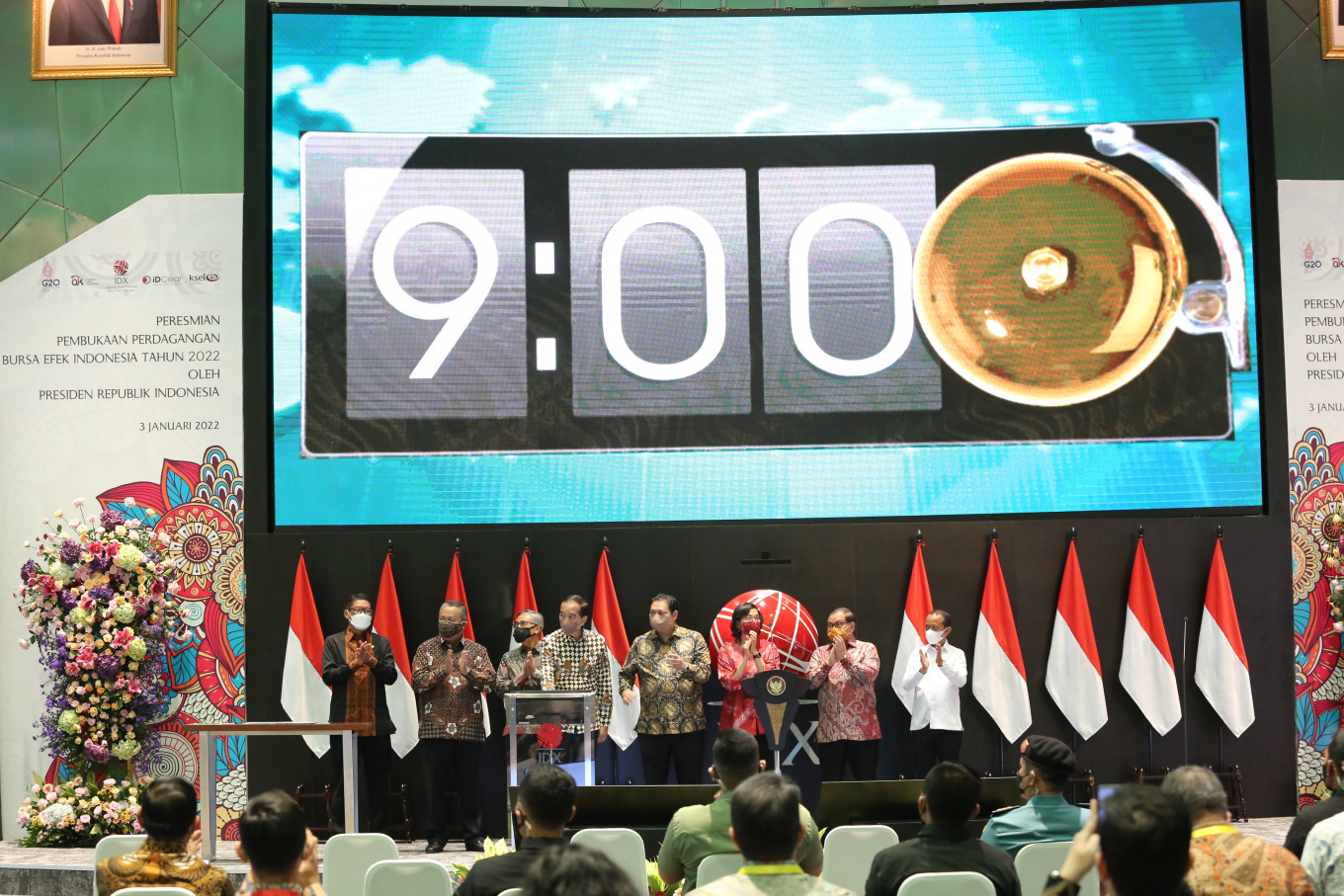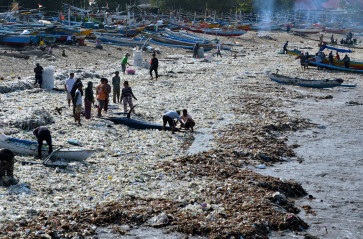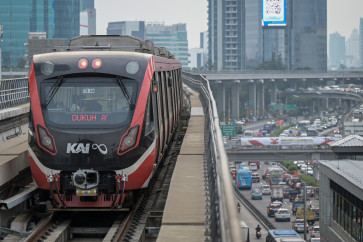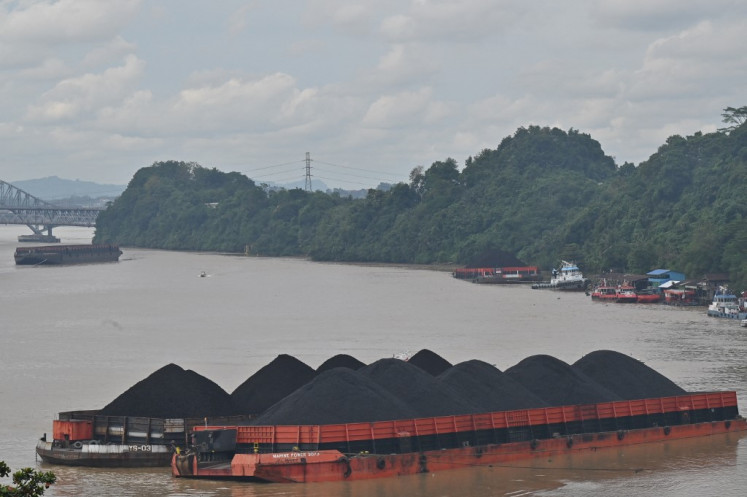Indonesia is a better-placed economy to avoid stagflation
Indonesia’s improving current account balance correlates inversely with the loan-to-deposit ratio, providing banks with more room to provide new lending.
Change text size
Gift Premium Articles
to Anyone

A
mid downside risks to growth and upside risks to inflation globally, we think Indonesia remains one of the better-placed economies in Asia.
Our view is based on three reasons: 1) Indonesia offers a stagflation hedge given its net commodity exporter status; 2) Its domestic demand economy is a safer play amid global demand uncertainty; and 3) Against a backdrop of deglobalization, it also offers a positive medium-term structural growth story.
Indeed, amid stagflation concerns, Indonesia seems well-placed as one of only three net commodity exporters within Asia (Australia and Malaysia being the other two). While Indonesia has tended to suffer from liquidity constraints in the past, given its net saving deficit status, positive terms-of-trade now provide the liquidity to fund Indonesia’s domestic demand.
Indonesia’s improving current account balance correlates inversely with the loan-to-deposit ratio, providing banks with more room to provide new lending. Positive terms-of-trade also provide the fiscal resources for policymakers to fund policy measures, helping to lend some cushion to the growth cycle.
As global recession concerns grow, investors have expressed concerns that Indonesia could be exposed on the downside. After all, commodities do not usually perform well in a global downturn.
While commodity price cycles have tended to be influenced by global demand, we think supply-side factors such as environmental, social and governance (ESG), weak capital expenditure (capex) expansion in traditional energy sources, weather disruptions and geopolitical tensions will also play an important role this time round. As such, our commodity teams’ price forecasts and the commodity futures curve suggest that even as prices moderate, they are likely to average at a level higher than 2019 pre-COVID-19 levels.
If this is the case, this would imply a redistribution of export income away from net commodity importers to net commodity exporters like Indonesia, favorably resetting its current account balance. Indeed, we expect Indonesia to see a current account surplus of +1.3 percent of gross domestic product in 2022 and a mild current account deficit of -0.3 percent of GDP in 2023. This would be a turnaround from the wider current account deficits seen in the past.
Second, if global demand is at risk, we think Indonesia offers a domestic demand buffer.
The earlier phase of the growth recovery in Indonesia had been led by exports but domestic demand lagged due to recurring COVID-19 waves and slow vaccination rates. Now, however, we see domestic demand catching up, driven by reopening, rising vaccination rates, improving mobility, better terms of trade, and a supportive policy environment.
Indeed, Indonesia’s domestic demand-oriented economy stands to benefit from this cyclical upswing in domestic demand. Furthermore, Indonesia’s relatively low trade linkages to slowing developing markets and China, also implies that the economy is less exposed to downside growth risks from global demand uncertainty.
Fiscal and monetary policy are two factors that markets are watching out for with regards to Indonesia’s domestic demand trajectory. In that regard, there are concerns about what the 3 percent fiscal deficit rule, energy subsidy reforms and 30 percent retail fuel price hike could mean for inflation, monetary policy, and growth.
So far, Indonesia’s inflation had been relatively manageable compared to other Asian economies because policymakers have used the fiscal balance-sheet to absorb inflation pressure and retail fuel prices have been marked to about US$50/bbl before the recent price hike. We calculate the recent price hikes will increase the consumer spending burden by 0.7 percent of GDP, all else equal. Yet, we do not expect this to derail Indonesia’s growth recovery for several reasons.
Most importantly, Indonesia is a commodity exporter and is ultimately a net beneficiary of elevated commodity prices.
Moreover, we expect headline and core CPI to peak at 6.6 percent year-on-year (yoy) and 4.3 percent yoy, respectively, in the coming months and this looks relatively manageable vs the high single-digit/double-digit inflation seen in the past. Besides, Bank Indonesia had tied the policy rate to the core inflation outlook and emphasized it will respond to second-round and not first-round inflation.
To the extent Indonesia is not operating above potential and given that the rupiah has held up well compared to regional currencies, we think disruptive tightening, which could short-circuit the growth cycle, looks unlikely. We see the terminal policy rate reaching 4.75 percent this year and the real policy rate reaching neutral territory.
Meanwhile, high-income households are usually better able to absorb price hikes given higher savings, but low-income households tend to be more affected given lower savings rates. That said, we think the policy offset measures for the latter group should mitigate some of the impact. Measures totaling Rp24 trillion, or 0.14 percent of GDP, have been announced, consisting of cash handouts, salary assistance to low-wage workers and transport cost subsidies for fishermen and motorcycle taxi drivers.
Third, and finally, as deglobalization takes hold, we think Indonesia offers a positive medium-term structural growth story.
Ongoing United States-China trade tensions, the COVID-19 pandemic, the geopolitical situation in Europe, and Taiwan cross-straits uncertainty are developments that point to an acceleration in deglobalization. In turn, deglobalization suggests structural global growth headwinds, which could see it become more difficult to extract growth and profitability from the global cycle, unlike in the past.
China’s own pivot toward a dual-circulation growth strategy that focuses on domestic consumption, also suggests that its growth model may not be as complementary for other parts of Asia as before.
Against this global backdrop, economies with favorable domestic structural growth stories, like Indonesia, should fare better. Indeed, the basic tenets of Indonesia’s structural story remain strong. It has one of the lowest indebtedness levels in Asia. It also benefits from benign demographics and improving macro stability. Indeed, the latter has driven a structural decline in the cost of capital in past years, incentivizing an investment-led growth cycle.
Also, to the extent that COVID-19 and geopolitical tensions have brought forth a need to diversify production supply chains, we think Indonesia could benefit in this regard. To that point, various structural reforms have been put in place, including the Jobs Creation Law and initiatives to build out the electric vehicle supply chain given Indonesia’s nickel ore supply.
For these reasons, we are bullish on Indonesia, both as a cyclical and a structural growth story. We project Indonesia’s GDP growth in 2024-26 at 5.7 percent yoy and expect its growth premium versus the global economy to widen further.
***
The writer is chief ASEAN, Korea, and Taiwan economist at Morgan Stanley.









